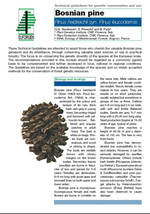Pinus heldreichii syn. Pinus leucodermis - Technical guidelines for genetic conservation and use for Bosnian pine
The main strategy adopted so far for the conservation of this species is linked with national parks and other protected areas. In Bulgaria for example, Bosnian pine is conserved in the Pirin National Park (where a 1200- year-old tree has been recorded) and in the Slavyanka Biosphere Reserve which includes the largest Bosnian pine habitat on the Balkan Peninsula. In Albania, 159 ha of P. heldreichii are located within national parks and recently established integrated nature reserves. In Italy, Bosnian pine is conserved in the Pollino National Park and Serbia has three natural reserves for the species. Throughout the former Yugoslavian republics, Bosnian pine is a protected species.
Conserving the diversity of Bosnian pine must include not only ecological and genetic considerations at local and landscape scales but also social, economic and legal issues. While national parks and nature reserves are a necessary first step for conserving this species, another indispensable step is acquiring and compiling knowledge on existing forest genetic resources. This information is available for the Italian and Greek populations but is still lacking for the rest of the natural range.
Designating in situ gene conservation units where appropriate forest management strategies are used is an efficient way of conserving the genetic resources of a target species, while making evolutionary changes possible over time. Genetic diversity and adaptability can be conserved from one generation to the next by conserving sufficiently large populations of locally adapted trees and allowing natural regeneration from a large-enough number of parents. Forest stands of more than 20 hectares, established from local seed sources and managed for nature conservation, could qualify as gene conservation units for Bosnian pine.
Exotic or unknown Bosnian pine material should not be grown within the remaining stands or in their vicinity. Natural regeneration should be closely monitored and assisted by sowing locally collected seeds if needed.
Bosnian pine also needs to be protected from two common man-made disturbances: forest fires and over-grazing. The Italian populations are under a particularly intense threat from both. Fires can cause rapid and drastic reduction of the population size by killing adult trees with consequent losses in seedling genetic diversity and adaptive potential. Intensive grazing prevents natural regeneration and may also lead to local extinction when adult trees die.
Ex situ conservation should be used if forests are under pressure or if their genetic resources are of particular interest (for example the marginal Italian populations). Ex situ stands must be established with care to represent the original genetic diversity of a population. Given the high inbreeding and low outcrossing rates of this species, ideally seeds should be collected from a large number of trees (approx. 100) and from trees growing at least 100 meters apart. Ecological conditions of the ex situ conservation site should be comparable to those of the original sites, possibly with lower environmental stress. Such an ex situ collection exists in southern Italy (Pollino mountain, Calabria), covering approximately 60 hectares.
Authors: Giovanni Giuseppe Vendramin; Silvia Fineschi; Bruno Fady
Journal/Series: EUFORGEN Technical Guidelines for Genetic Conservation and Use
Publication Year: 2008
Publication Format: 17x24 Softcover; PDF
ISBN 13: 978-92-9043-789-5
Language: EN
Pages: 6 p.

